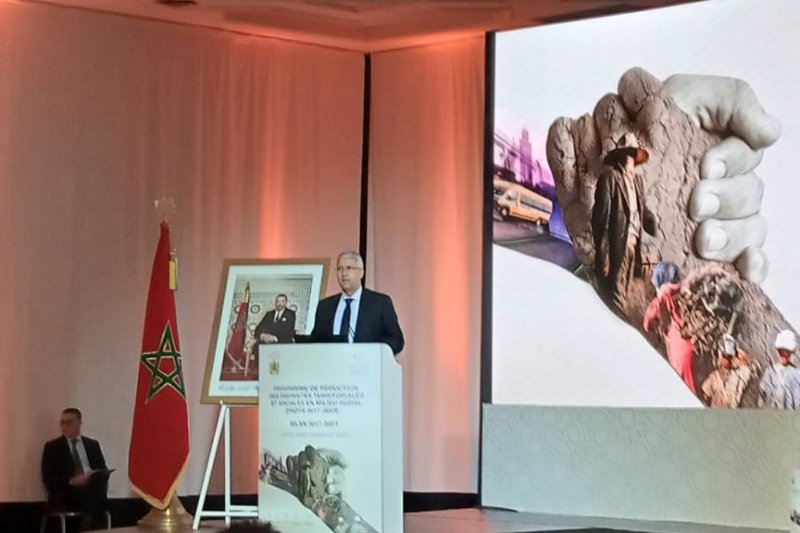9 suspects charged in historic $20 million airport gold heist

83% of local authorities targeted in 2017/21
The report on the implementation of the Program for the Reduction of Territorial and Social Disparities in Rural Areas (2017-2023), for the period 2017/21, was presented this Thursday, April 14 in Rabat by the National Commission for the Development of Rural Space and Mountain Zones, under the presidency of the Ministry of Fisheries and Agriculture.
The PRDT is the emanation of the will of King Mohammed VI, who laid the foundations for it during the royal speech of July 30, 2015. On this occasion, he gave his high instructions to the government to develop an integrated program targeting the regions isolated and disadvantaged, and this through an intervention aimed at opening up remote and mountainous regions through the construction of roads, rural tracks and works of art, in order to improve the standard of living of rural populations and enable them to benefit equitably from the natural and economic opportunities and resources of these spaces.
The King also insisted on the improvement and generalization of the access of rural populations to basic services related to electricity, drinking water, education and health and to create the conditions necessary to strengthen and diversify the economic capacity of rural space and mountainous areas.
The National Commission composed of the Ministries of Agriculture, the Interior (General Directorate of Territorial Communities and National Coordination of the National Initiative for Human Development), Economy and Finance, Equipment, of Health, National Education and ONEE, therefore presented this Thursday the genesis, the objectives and the approach of this royal project which aims to upgrade the rural world in all regions of the Kingdom. , as well as its governance bodies and the report on the achievements of the 2017-2021 action plans.
It is therefore a program with multiple interventions and sources of funding and responds to the principle of advanced regionalization, said Thursday Mohammed Sadiki, Minister of Agriculture, Maritime Fisheries, Rural Development and Water and Forests, during his speech during the presentation of the 2017-2021 report.
Thus, a financial envelope of 50 billion dirhams is allocated to it, which is distributed between the targeted sectors, namely roads, rural tracks and engineering structures (35.4 billion dirhams), drinking water supply (6 billion dirhams), Education (5 billion dirhams), Rural Electrification (2 billion dirhams) and Health (1.4 billion dirhams), recalled the Minister.
As for the sources of funding, they are for their part distributed between the Fund for Rural Development and Mountain Areas (FDRZM) (47%), the Regional Councils (40%), the Fund for the National Initiative for National Office (8%) and the National Office for Electricity and Drinking Water (5%).
83% of local authorities targeted in 2017/21
The program has adopted the governance framework resulting from the government policy on the development of rural space and mountain areas, approved by the Permanent Interministerial Commission for the Development of Rural Space and Mountain Areas (CIPDERZM) in July 2015.

This framework provides for the creation of governance bodies at the central and regional levels, namely the National Commission for the Development of Rural Space and Mountain Areas (CNDERZM) and the Regional Commissions for the Development of Rural Space and Mountain Areas. de Montagne (CRDERZM), which bring together the technical services of the ministerial sectors and the public establishments concerned.
Regarding the implementation of the annual action plans during the period 2017-2021, the Minister of Agriculture explained that they targeted 1,066 local authorities in the rural world corresponding to 83% of the total of local authorities. of the Kingdom. In addition, 142 rural centers as well as urban communes which experience regular migratory flows of the rural population (59 urban communes) have benefited from these projects to reduce territorial and social disparities, the minister specified.
In total, the beneficiary population is approximately 14 million, and more than 103 million working days have been created, generating 234,000 direct and indirect jobs.
” The impact of the completed projects is reflected in the reduction of access time to health services and educational establishments, as well as the opening up of agricultural perimeters and tourist sites.“, noted the minister.
These projects, Sadiki continued, enabled 27% of the beneficiaries of the construction of roads and rural tracks to develop non-agricultural economic activities. Thus, the enrollment rate for rural girls rose to 60% in the targeted areas, an increase of 15% compared to 2017.

Similarly, school wastage has been reduced by 16% in the targeted areas, with a significant improvement in schooling conditions thanks to the completed projects, in particular roads and connection to the water and electricity networks.
Also according to the government official, the accessibility and quality of health services have been improved by 98% through the construction projects of health facilities and the acquisition of ambulances and mobile medical units, the reduction, respectively , distance and time required for water supply by 81 and 82% and a significant improvement in the quality of drinking water by 95% at individual connections and 65% at standpipes.
The Program for the Reduction of Territorial and Social Disparities in Rural Areas 2017-2023 has achieved most of its objectives in terms of territorial targeting and the completed projects have contributed significantly to improving the standard of living of the populations of the beneficiary groups, said Sadiki, who noted that the implementation of the PRDTS 2017-2023 will continue in the same vein and the implementation of the scheduled projects will continue to achieve the objectives set for 2023.
.
